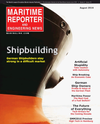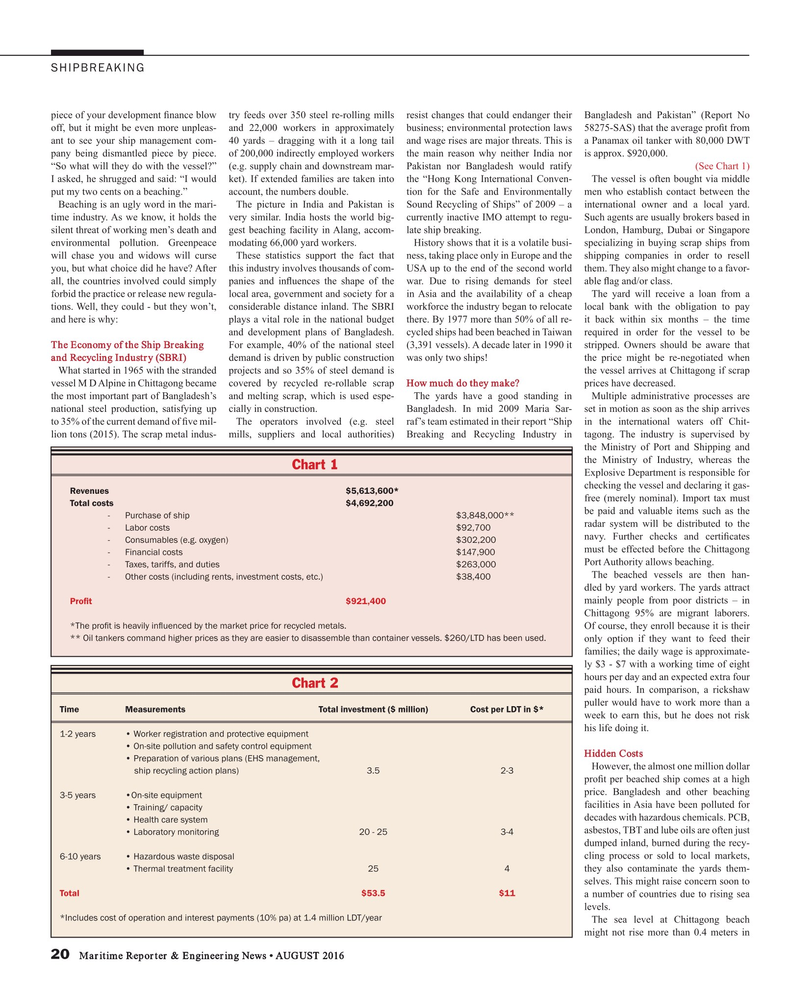
Page 20: of Maritime Reporter Magazine (August 2016)
The Shipyard Edition
Read this page in Pdf, Flash or Html5 edition of August 2016 Maritime Reporter Magazine
SHIPBREAKING piece of your development ? nance blow try feeds over 350 steel re-rolling mills resist changes that could endanger their Bangladesh and Pakistan” (Report No off, but it might be even more unpleas- and 22,000 workers in approximately business; environmental protection laws 58275-SAS) that the average pro? t from ant to see your ship management com- 40 yards – dragging with it a long tail and wage rises are major threats. This is a Panamax oil tanker with 80,000 DWT pany being dismantled piece by piece. of 200,000 indirectly employed workers the main reason why neither India nor is approx. $920,000. “So what will they do with the vessel?” (e.g. supply chain and downstream mar- Pakistan nor Bangladesh would ratify (See Chart 1)
I asked, he shrugged and said: “I would ket). If extended families are taken into the “Hong Kong International Conven- The vessel is often bought via middle put my two cents on a beaching.” account, the numbers double. tion for the Safe and Environmentally men who establish contact between the
Beaching is an ugly word in the mari- The picture in India and Pakistan is Sound Recycling of Ships” of 2009 – a international owner and a local yard. time industry. As we know, it holds the very similar. India hosts the world big- currently inactive IMO attempt to regu- Such agents are usually brokers based in silent threat of working men’s death and gest beaching facility in Alang, accom- late ship breaking. London, Hamburg, Dubai or Singapore environmental pollution. Greenpeace modating 66,000 yard workers. History shows that it is a volatile busi- specializing in buying scrap ships from will chase you and widows will curse These statistics support the fact that ness, taking place only in Europe and the shipping companies in order to resell you, but what choice did he have? After this industry involves thousands of com- USA up to the end of the second world them. They also might change to a favor- all, the countries involved could simply panies and in? uences the shape of the war. Due to rising demands for steel able ? ag and/or class. forbid the practice or release new regula- local area, government and society for a in Asia and the availability of a cheap The yard will receive a loan from a tions. Well, they could - but they won’t, considerable distance inland. The SBRI workforce the industry began to relocate local bank with the obligation to pay and here is why: plays a vital role in the national budget there. By 1977 more than 50% of all re- it back within six months – the time and development plans of Bangladesh. cycled ships had been beached in Taiwan required in order for the vessel to be
The Economy of the Ship Breaking For example, 40% of the national steel (3,391 vessels). A decade later in 1990 it stripped. Owners should be aware that and Recycling Industry (SBRI) demand is driven by public construction was only two ships! the price might be re-negotiated when
What started in 1965 with the stranded projects and so 35% of steel demand is the vessel arrives at Chittagong if scrap vessel M D Alpine in Chittagong became covered by recycled re-rollable scrap How much do they make? prices have decreased.
the most important part of Bangladesh’s and melting scrap, which is used espe- The yards have a good standing in Multiple administrative processes are national steel production, satisfying up cially in construction. Bangladesh. In mid 2009 Maria Sar- set in motion as soon as the ship arrives to 35% of the current demand of ? ve mil- The operators involved (e.g. steel raf’s team estimated in their report “Ship in the international waters off Chit- lion tons (2015). The scrap metal indus- mills, suppliers and local authorities) Breaking and Recycling Industry in tagong. The industry is supervised by the Ministry of Port and Shipping and the Ministry of Industry, whereas the
Chart 1
Explosive Department is responsible for checking the vessel and declaring it gas-
Revenues $5,613,600* free (merely nominal). Import tax must
Total costs $4,692,200 be paid and valuable items such as the - Purchase of ship $3,848,000** radar system will be distributed to the - Labor costs $92,700 navy. Further checks and certi? cates - Consumables (e.g. oxygen) $302,200 must be effected before the Chittagong - Financial costs $147,900
Port Authority allows beaching.
- Taxes, tariffs, and duties $263,000
The beached vessels are then han- - Other costs (including rents, investment costs, etc.) $38,400 dled by yard workers. The yards attract mainly people from poor districts – in
Pro? t $921,400
Chittagong 95% are migrant laborers. *The pro? t is heavily in? uenced by the market price for recycled metals.
Of course, they enroll because it is their ** Oil tankers command higher prices as they are easier to disassemble than container vessels. $260/LTD has been used.
only option if they want to feed their families; the daily wage is approximate- ly $3 - $7 with a working time of eight hours per day and an expected extra four
Chart 2 paid hours. In comparison, a rickshaw puller would have to work more than a
Time Measurements Total investment ($ million) Cost per LDT in $* week to earn this, but he does not risk his life doing it. 1-2 years • Worker registration and protective equipment • On-site pollution and safety control equipment
Hidden Costs • Preparation of various plans (EHS management,
However, the almost one million dollar ship recycling action plans) 3.5 2-3 pro? t per beached ship comes at a high price. Bangladesh and other beaching 3-5 years •On-site equipment facilities in Asia have been polluted for • Training/ capacity decades with hazardous chemicals. PCB, • Health care system asbestos, TBT and lube oils are often just • Laboratory monitoring 20 - 25 3-4 dumped inland, burned during the recy- cling process or sold to local markets, 6-10 years • Hazardous waste disposal they also contaminate the yards them- • Thermal treatment facility 25 4 selves. This might raise concern soon to
Total $53.5 $11 a number of countries due to rising sea levels.
*Includes cost of operation and interest payments (10% pa) at 1.4 million LDT/year
The sea level at Chittagong beach might not rise more than 0.4 meters in 20 Maritime Reporter & Engineering News • AUGUST 2016
MR #8 (18-25).indd 20 MR #8 (18-25).indd 20 8/1/2016 2:05:47 PM8/1/2016 2:05:47 PM

 19
19

 21
21
